The entirety of the charting completed for this study can be found linked here.
For years, the start of an NFL game has looked, sounded, and felt the same.
The ball is set on the tee and the kicking team flanks each side. A percussive sound rings through the stadium as the return team lines up. The kicker measures out each step, jogs to the ball, and sends it soaring through the sky as a flash of cameras catch the moment the coverage unit crosses the ball in unison.
The sounds of gameday will remain the same in 2024, but the opening kickoff will look very different. After the lowest kick return rate in NFL history in 2023, the NFL owners approved a new kickoff rule by a vote of 29-3 at this year’s league meetings.
The new kickoff is a spin on the low-impact kickoff that was researched and used in the XFL and later popped up in the European League of Football. Gone are long run ups, booming the ball out of the end zone, and layered wedges. In are shuffle techniques, mini blocking schemes, and crucially, many more kick returns.
For the 2024 season, kickoffs will look a little bit like this:
To get a better idea of what to expect for the 2024 NFL season, I watched, charted, and broke down all 400+ kickoffs (check out all of the data here) from the 2023 XFL season.
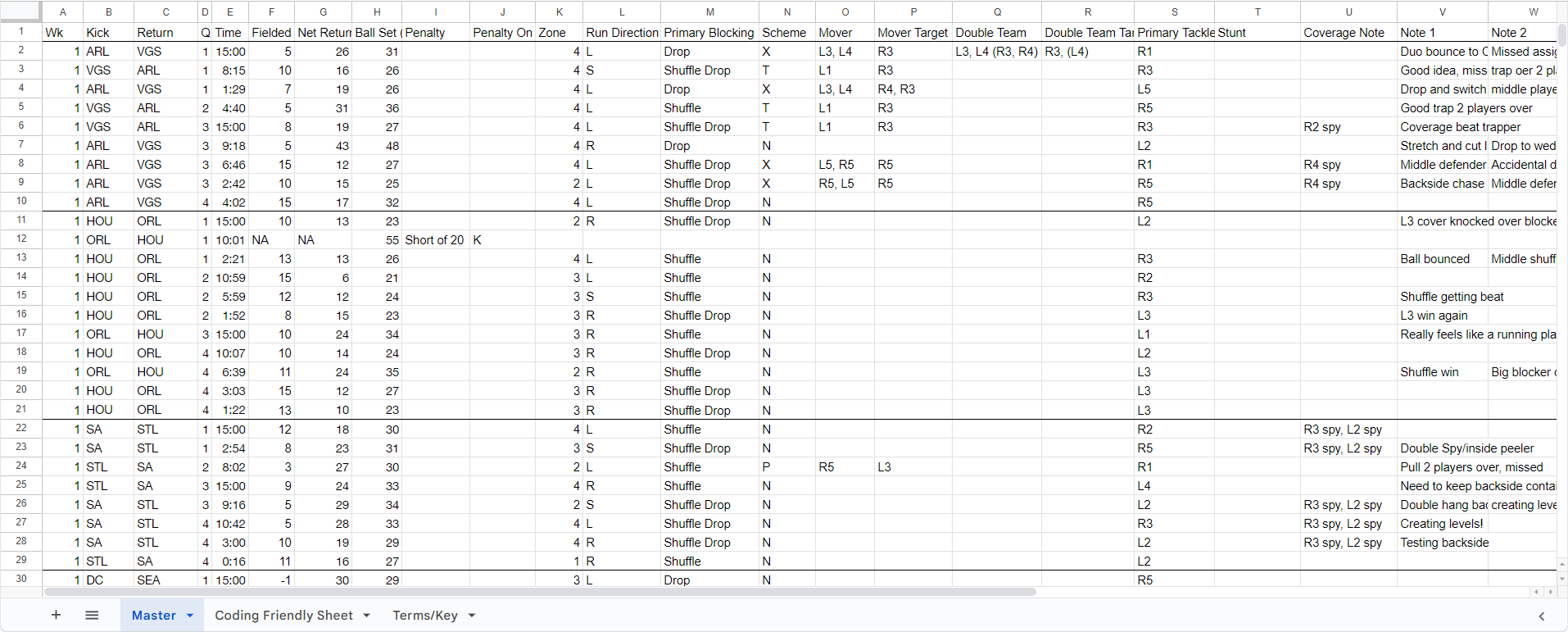
Before getting into what I found on film and what the data showed, let’s look closer at the new kickoff rules.
The Basics

- The new kickoff will require the kicking team to have 10 players lined up with their lead foot on the receiving team’s 40-yard line (the restraining line).
- The receiving team’s setup zone will have at least nine players and will require seven of those players to have their lead foot on their own 35-yard line with alignment requirements based on the field’s landmarks (i.e., numbers and hashes).
- Two of the nine players in the return team’s setup zone can be off the 35-yard line within a five-yard range but must remain outside the hashmarks.
- The kickoff team and all return team players in the setup zone cannot move until the ball is either caught or hits the ground. The returner or returners may move around freely before the ball is live.
- The kicker cannot cross the 50-yard line until the ball hits the ground or a returner.
The Landing Zone
The most important rules to know this year surround the landing zone. The landing zone is the space on the field between the receiving team’s 20-yard line and the goal line.
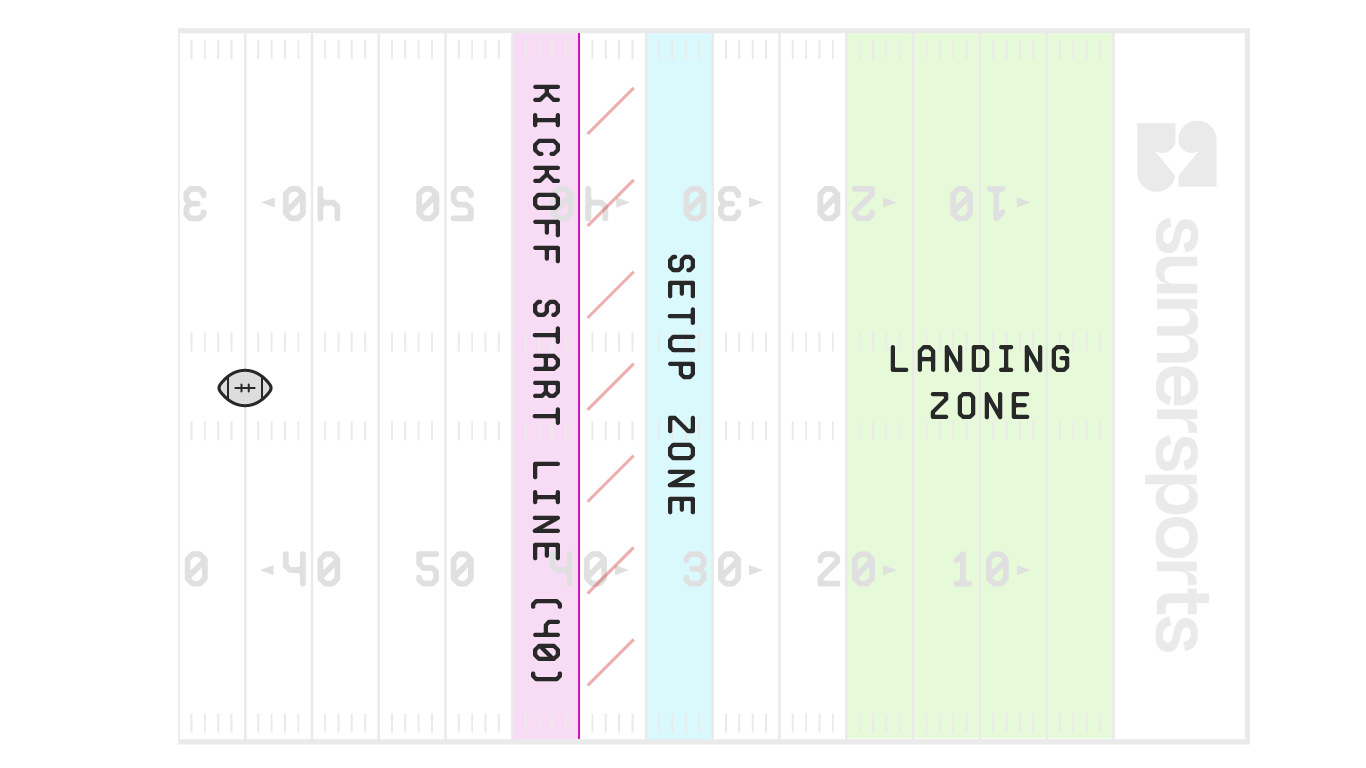
- If a kick falls into the landing zone, the ball must be returned; there are no fair catches.
- A kick that lands short of the landing zone or is kicked out of bounds before the goal line will be placed on the receiving team’s 40-yard line.
- A kick that hits the landing zone and then goes into the end zone must be returned or downed by the receiving team. If the ball is downed in the end zone or if it goes through the end zone after hitting the landing zone, it will be placed on the receiving team’s 20-yard line.
- A ball kicked into the end zone and downed or through the back of the end zone will be placed on the receiving team’s 30-yard line.
- Onside kicks are only allowed in the 4th quarter as declared by the trailing team.
For more details on the new kickoff rule, NFL Football Operations has you covered.
The XFL Kickoff
The 2024 NFL kickoff rules differ from the XFL rules that were used in 2023 and are important to note before digging into the study:
2023 XFL Kickoff Rules | 2024 NFL Kickoff Rules |
Ball was kicked from the kicking team’s 30-yard line | Ball will be kicked from the kicking team’s 35-yard line |
Kicking team had their lead foot on the return team’s 35-yard line | Kicking team will have their lead foot at the return team’s 40-yard line |
10 players from the return team had their lead foot on the return team’s 30-yard line | At least nine players from the receiving team will be in the setup zone and at least seven players will have their lead foot on the return team’s 35-yard line |
Kicks short of the landing zone or out of bounds short of the goal line were placed at the kicking team’s 45-yard line | Kicks short of the landing zone or out of bounds short of the goal line will be placed at the return team’s 40-yard line |
Kicks straight through the back of the end zone were placed on the return team’s 35-yard line | Kicks straight through the back of the end zone will be placed on the return team’s 30-yard line |
Kicks that hit the landing zone and went through the back of the end zone were placed on the return team’s 15-yard line | Kicks that hit the landing zone and go straight through the back of the end zone will be placed on the return team’s 20-yard line |
Ball was not live until caught or on the ground for three seconds | Ball will be live once it is caught or once it hits the ground |
2023 XFL Kickoff Study
My goal for studying the 2023 XFL kickoff was to see the common, creative, and most successful strategies that both kicking and receiving teams used under the specific rules. From the kicking team’s perspective, I broke the field into five zones (more on that below) where the ball could land. I decided on the below five zones to keep the zones tied to landmarks as kickers will have on-field visual cues to kick the ball to even if each zone is not the exact same width.
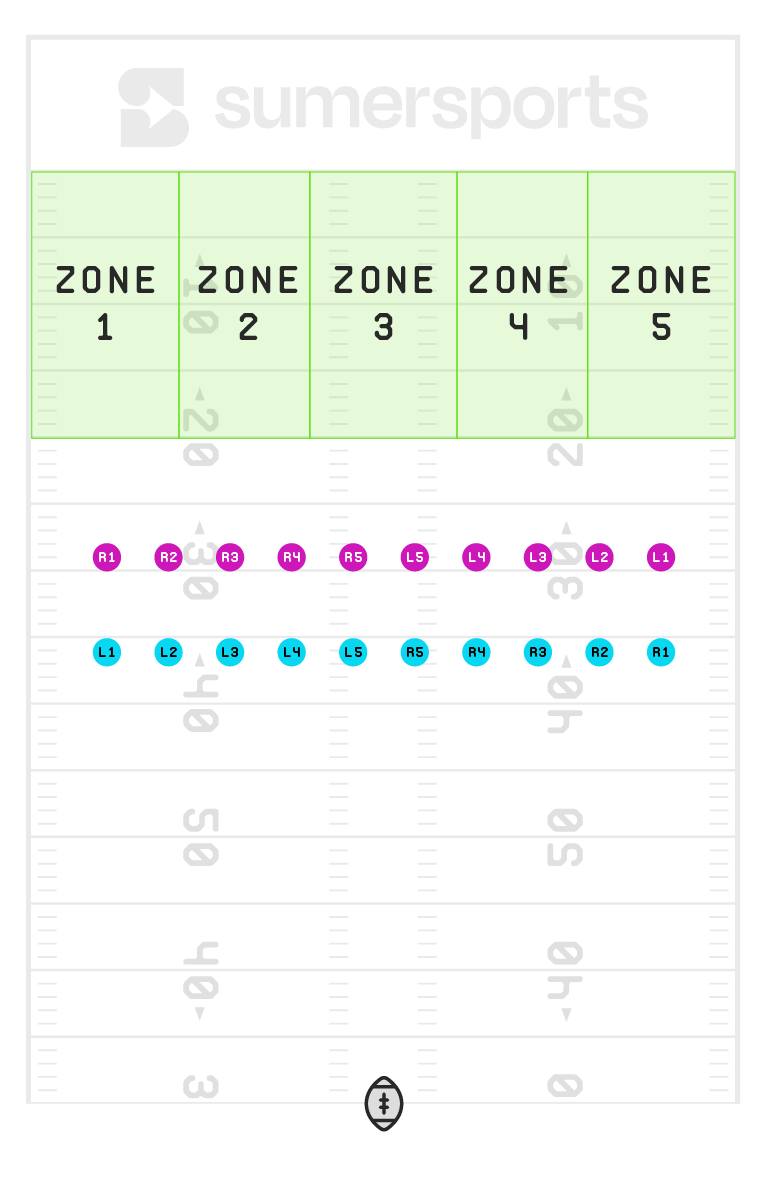
I also labeled each team’s players from one through five on the left and right side based on the unit’s perspective for reference purposes.
Zones
For charting purposes, I cut the field into five different zones based on field landmarks to see which areas produced the best results. The zones are only labeled from the kicking team’s perspective and are as follows:
- Zone 1 – Left sideline to left side of left numbers
- Zone 2 – Left side of left numbers to 2 yards off left hash
- Zone 3 – 2 yards off left hash to 2 yards off right hash
- Zone 4 – 2 yards off right hash to right side of right numbers
- Zone 5 – Right side of right numbers to right sideline
| Zone 1 | Zone 2 | Zone 3 | Zone 4 | Zone 5 |
Average Ball Spot | 29.6 | 28.0 | 28.1 | 29.4 | 28.9 |
Average Ball Caught Yard Line | 5.2 | 7.4 | 8.2 | 8.3 | 9.9 |
Total Charted | 42 | 112 | 105 | 90 | 17 |
Primary Blocking
Blocking on the new kickoff will look more like a basketball shuffle instead of the high impact wedge busting of years past and will resemble a running back picking up a linebacker on a blitz. The impact should be lower, but the proper technique will be difficult as multiple blockers were caught holding when the ball bounced outside in a hurry. On the backside of returns, there is often a chase effect where the return team is just looking to cut off the coverage unit as they pursue the returner.
The film led to three distinct types of Primary Blocking that all had their own purpose, upside, and downside. I broke the core techniques down based on how far the blockers were setting up from their starting point on the play side.
| Shuffle | Shuffle Drop | Drop |
Average Ball Spot | 28.9 | 26.8 | 28.8 |
Average Net Return Yards | 21.1 | 19.1 | 21.2 |
Total Charted | 284 | 57 | 25 |
Shuffle
Shuffle blocking occurs when blockers quickly square their shoulders to the coverage unit and set their feet between 0 and 2 yards from the initial restraining line. This creates a more sudden impact and can be a way to initiate the block immediately. The rare instances where a return team blocker would cross the setup zone line after the ball was fielded are also captured under Shuffle.
Here is an example of a team using Shuffle blocking. Note how quickly the return team squares to the coverage unit:
Shuffle Drop
Shuffle Drop blocking occurs when the return team sets their blocking unit between 2 and 4 yards off the initial line. This gives the blockers a bit more time to prepare themselves and brace for the oncoming impact. In practice, it would sometimes put the blockers in a tough spot as they were off balance and tried to catch coverage players only to be thrown off quickly. In the below Shuffle Drop example, note the blockers at the top of the screen:
Drop
Drop blocking occurs when the return team sets their blocking unit 4 or more yards off the initial line. In the below Drop example, the blockers at the bottom of the screen look like they are linebackers dropping into zone coverage:
Scheme
The new kickoff will have a schematic spin that will allow special teams coordinators to experiment with different blocking setups on the way to success. The return feels like a running play, and both the return team and coverage team should try different schemes that borrow from the common run game framework. The table below does not include the plays that featured multiple schemes:
| None | X | Pull | Trap | Double | Power |
Average Net Return Yards | 20.0 | 19.0 | 26.5 | 15.7 | 21.5 | 20.0 |
Average Ball Spot | 27.9 | 26.1 | 34.2 | 24.6 | 29.3 | 25.3 |
Total Charted | 248 | 17 | 50 | 7 | 23 | 3 |
None

A majority of the returns in the study are labeled as None in the scheme category. This indicates that each of the 10 players on the receiving team were assigned to block the coverage player lined up across from them in a type of man-to-man blocking. This is the most vanilla of the blocking schemes:
X
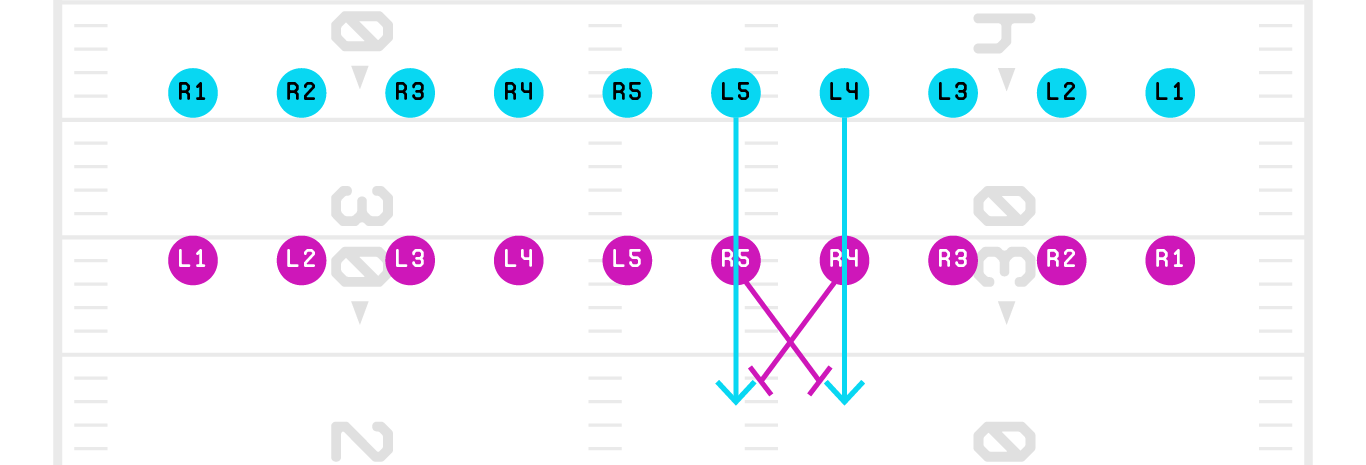
An X block occurs when two blockers next to each other cross and switch blocking assignments. This can surprise the coverage players or give players a better angle to execute a block and open up a lane for the returner. Below is an R5, L5 X:
Pull
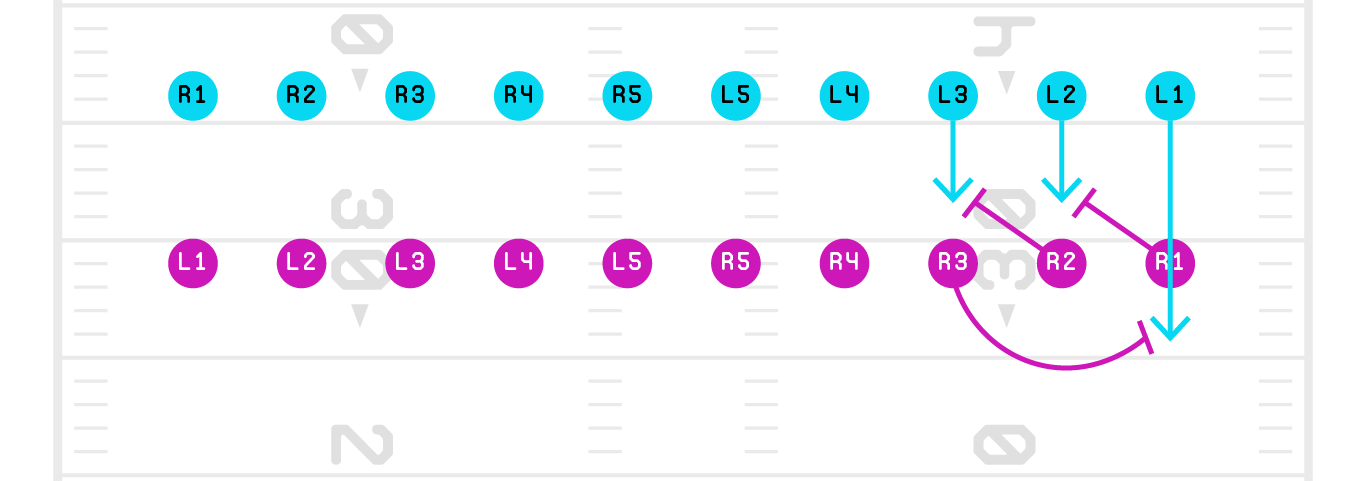
A Pull is a block where a player goes from inside to outside over the distance of more than one player. This helped returners capture the edge or open a lane inside of the puller while two or more other blockers had an angle advantage as they blocked down the line. The Pull scheme's success may encourage NFL teams to try it, and the NFL's alignment rules allowing for some players to start off the restraining line would make the angles even better.
Below the return team’s R4 is pulling to block the coverage team’s L1:
Trap
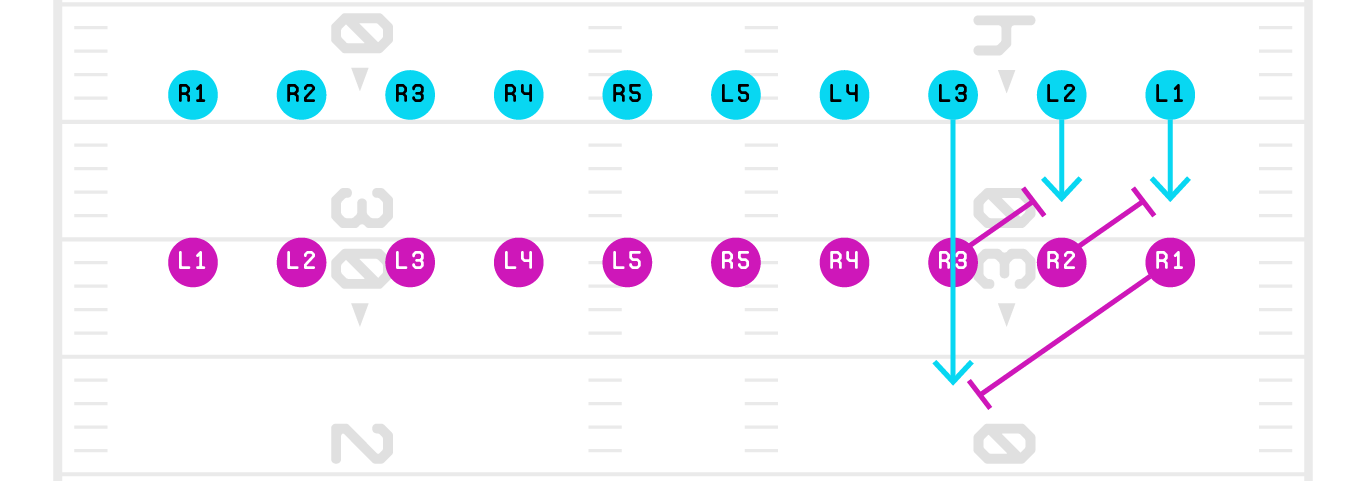
A Trap is a block where a player goes from outside to inside to block a player more than one player over. Trap schemes functioned the way they did in the run game; a coverage player would dart down the field thinking they were free until a blocker surprised them.
Here the return team’s L1 is trapping the coverage unit’s R3:
Though the Trap is great on paper, it did see its fair share of struggles. Based on the alignment requirement, Trap blockers were sometimes not fast enough to block their target. This could be different in the NFL as a Trap blocker could line up off the restraining line, though that could tip off the other side as to what is coming.
Here the return team’s R1 was flagged while attempting a Trap block:
Double

Double is a scheme where two blockers block one coverage player while another coverage player is left unblocked. This has a similar visual effect to some Duo runs, but the impact is different as there are no linebackers to draw forward.
In the below clip the return team’s R2 and R3 are double team blocking while the return team’s R1 is also blocking down, which leaves the coverage unit’s L1 unblocked:
Power
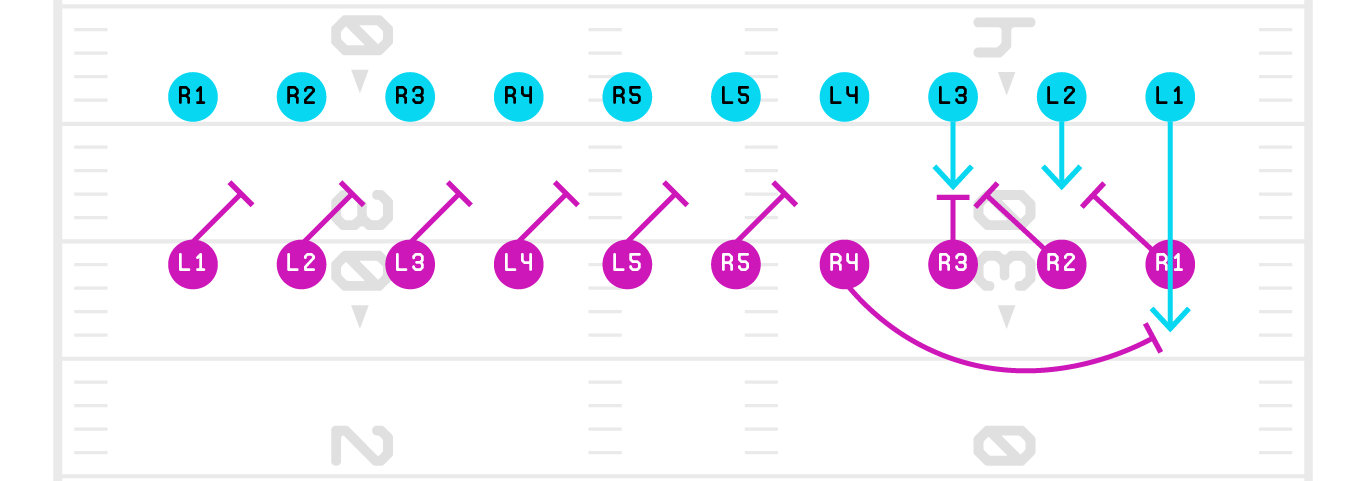
Power is a rare scheme used where there is a double team and a puller that crosses behind the double team. This scheme is similar to the run scheme of the same name. The below clip has the return team’s R2 and R3 double teaming while L5 is pulling around:
Reverse
A reverse is when the returner hands the ball off to one of the return team’s other players going in the opposite direction. Teams also used fake reverses similar to the Shanahan tree’s fakes on outside zone.
Trick
I labeled one play in the 2023 data as a Trick. It was a throwback that was exciting to watch but only led to 18 net return yards:
Kickoff Coverage
Kickoff coverage units were less scheme diverse than kick return units, but the film highlighted some key takeaways. Coverage players that were able to maintain their leverage like a two-gapping run defender (as the coverage unit’s R3 did in the clip below) will play an important role in reigning in returners.
Players that can successfully win on the interior, like R5 in the clip below, are also sure to create splash plays for the kickoff unit. Returners that pause to find new lanes or spend too much time dancing before getting vertical will find inside pressure hitting fast; returners that kept a straight path averaged two more average net return yards than those I charted as going left or right.
Most importantly, the kickoff unit must find a way to create multiple levels of coverage players. If every member of the coverage unit stayed on the same yard line, there would only be one level for the returner to clear and one broken tackle would mean a foot race to the end zone.
Teams created different levels by overlapping backside players to the frontside, folding outside players to the inside, staggering their attack, and using some schematic creativity through Stunts and Spies.
Stunt

A Stunt is where two or more coverage players cross over each other’s vertical lane by design. This sometimes occurred between just two players, but there were also three player Stunts. These Stunts made it harder for blocking units to maintain their Shuffle man to man blocking as the players now had to either pass the coverage players off or risk running into each other.
Here the coverage unit’s L2 is Stunting with the coverage unit’s L1 by targeting the return team’s R1. L1 creates a different layer for the coverage unit and becomes a free hitter:
Spy

Another coverage variation was a Spy. A Spy is a coverage player that would hang back instead of attacking the returner once the play started. These Spies would overlap late, and teams often had their edge players (R1 and L1) Spy to help on returns that ended up breaking for big gains.
In end of game situations teams would use multiple Spies. In the NFL those teams may elect to just kick the ball out of the back of the end zone or try a knuckleball kick (more on that later!) with multiple Spies.
Here the kicking team’s R3 is a Spy and ends up making the tackle:
Tackler by Zone
Tackler | Zone 1 | Zone 2 | Zone 3 | Zone 4 | Zone 5 | Total |
K | 2 | 5 | 4 | 3 | 0 | 14 |
L1 | 8 | 13 | 6 | 3 | 0 | 30 |
L2 | 4 | 18 | 11 | 5 | 0 | 38 |
L3 | 6 | 12 | 13 | 5 | 0 | 36 |
L4 | 8 | 19 | 6 | 6 | 0 | 39 |
L5 | 0 | 11 | 10 | 8 | 2 | 31 |
R5 | 3 | 11 | 10 | 13 | 1 | 38 |
R4 | 2 | 5 | 14 | 9 | 1 | 31 |
R3 | 4 | 6 | 11 | 10 | 2 | 33 |
R2 | 3 | 6 | 10 | 10 | 6 | 35 |
R1 | 1 | 5 | 9 | 14 | 4 | 33 |
Tackling was dispersed across the five zones, but the L4 spot took the crown. Teams can either decide their position assignments by where they would like to kick to, or kick to a specific zone based on where their best coverage player likes to play. The back and forth of how coverage units and return units will adjust and try new things should add a layer of fun to the NFL this year.
Some Additional Thoughts
Aside from the data, there are some other considerations based on the film and the differences in the rules between the NFL and XFL.
The 10th player
Under the NFL rules, only nine return players are required to be in the setup zone and the 11th player will be in the landing zone. The 10th player has the most flexibility. There are three ways this 10th player is likely to be used and one that is the most fun:
- The 10th player could just be in the setup zone as another blocker. This would make the kickoff look almost the same as the 2023 XFL kickoffs examined here.
- The 10th player could be a second returner. The XFL returners did not have major issues tracking the ball, but a high-level NFL kicker should be able to maintain a low and fast enough trajectory to bounce the ball through the landing zone, which would allow the coverage unit to start chasing the ball before it is even fielded. A ball that bounces in the landing zone and is downed in the end zone would be placed on the return team’s 20-yard line, which heavily incentivizes return teams to field the ball in play and encourages kickoff units to try a knuckleball strategy.
- The 10th player could be used as a lead blocker. As long as the return player can track the ball, a lead blocker would give the return team flexibility if a player in the setup zone misses a block. The lead blocker could also help create double teams and open up seams with force. If the 10th player is a lead blocker, the other blockers will either be in zone pickup blocking or leave one player unblocked. Edge players away from the ball are less likely to make tackles on the play so they could be left unblocked to start.
- Finally, the 10th player could be an option pitch threat. Though teams will be hesitant to implement a risky pitch, teams that can create a speed option type of play and put pressure on a read defender may find themselves stealing extra yards. If a team chooses to create a rugby style return where there are multiple pitch players, I will be cheering loudest.
Kickers and Tackling
There have been some rumblings about teams using position players to kick, and the idea is not ridiculous. With each zone producing a similar average starting field position and kickers being the primary tackler 14 times (which does not include their missed tackles, secondary involvement, nor general influence on the play), there is a role for a kicker that can hold their own on the return. However, a better strategy may be for kickers to craft the perfect knuckleball.
Knuckleball? Low Line Drive?
I am of the opinion that NFL kickers can become very good at placing the ball where they want to on the new kickoff. Under the new rules, a ball that bounces inside the 20-yard line in front of the returner will allow the coverage team to be off to the races. Kickers for every single team should be practicing the art of the low line drive knuckleball that bounces in the front part of the landing zone and dies down closer to the end zone. Once the ball hits the ground, the coverage unit will be able to pressure a returner who has to field the ball in a hurry. The XFL rules discouraged the knuckleball by not starting the play until the ball was fielded or on the ground for a full three seconds.
Though the new rule will almost certainly lead to more kick returns, the best kickoff units should be able to put teams behind last year's 25-yard touchback line on a consistent basis with a bouncing knuckleball kick.
Personnel and Positioning
XFL teams had unique personnel groupings for both kickoffs and kick returns. Some teams tried offensive linemen as blockers, but they were not fast enough to execute the blocks in space. Others used smaller faster players at the R5 and L5 position despite a size disadvantage.
The new kickoff should open up opportunities for backup tight ends and end of the depth chart linebackers that are strong enough to anchor a block and agile enough to win with one quick move against a blocker. Positions that have been devalued in the modern NFL like running backs and safeties may also find themselves as prime players on kickoff and kick return while cornerback types excel on the outside.
Keeping Teams on Their Toes
While watching each kickoff, teams began to develop personalities in both the coverage and blocking aspects of the play. Some teams consistently had inside players sprinting down the field for big tackles while others had inside players hang back. Some blocking units would shuffle right away to start a block while others pulled on multiple attempts. Being able to kick to different zones away from where a team wants to set up their blocking will help kicking teams have an advantage while having the versatility across the blocking line to set up a specific scheme in multiple spots based on where the ball lands will help the return team.
Conclusion
Aside from strategic nuance and rule manipulation, the change in the NFL kickoff is going to have a tangible impact on the field; there will likely be an increase in the percentage of kickoffs returned this season.
More players will find their name on the stat sheet and great players will emerge in different ways, on both the kicking and returning side. The best special teams coordinators will be able to get the most out of their players executing the fundamental techniques of football but will also find creative ways to open and close space for returners. The best kickers will also give their team an advantage by how they kick the ball into the landing zone.
Instead of checking the box and starting a drive at the 25 yard-line, teams will have to earn their starting field position. Each yard added onto the start of a drive increases a team’s chance to score points, but kickoff units may find that the differences in the XFL rules and NFL rules fall in their favor. Still, teams may decide to kick the ball through the end zone if surrendering the 30-yard line is not a strong enough disincentive as they avoid the dreaded kick return touchdown.
Above all, though, I hope you got a kick out of this.
Special thanks to Tej Seth and Sam Bruchhaus for helping to organize my charting data.




